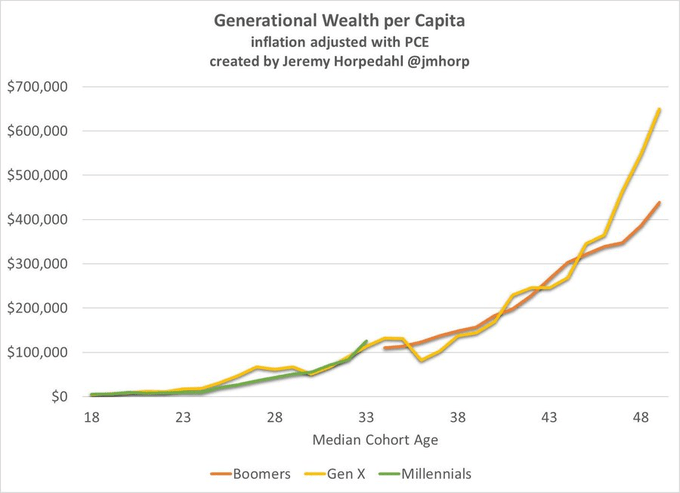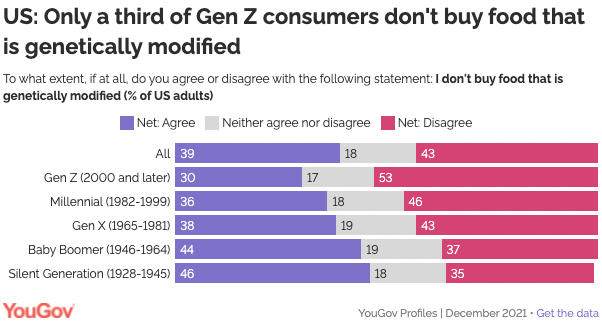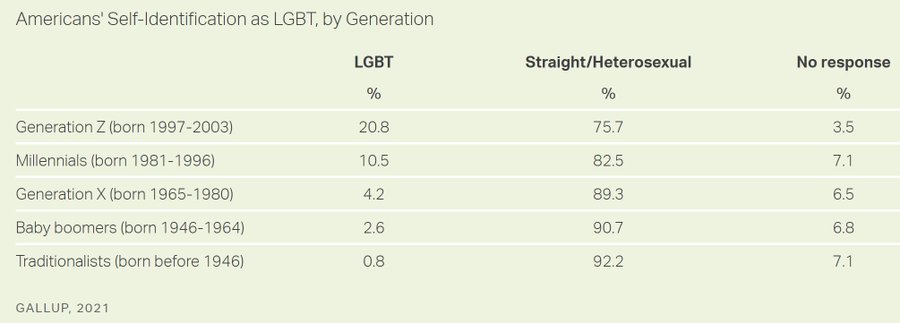All the ways Millennials and Gen Z are different
America is changing. Millennials and Gen Z are coming of age. Here are all the ways that they are different from previous generations.
Sex and gender
According to Gallup data, about 21% of Generation Z adults now identify as LGBTQ.
Fewer young adults are engaging in casual sexual intercourse now than in the past, but the reasons for this decline are unknown. The authors use data from the 2007 through 2017 waves of the Panel Study of Income Dynamics Transition into Adulthood Supplement to quantify some of the proximate sources of the decline in the likelihood that unpartnered young adults ages 18 to 23 have recently had sexual intercourse. Among young women, the decline in the frequency of drinking alcohol explains about one quarter of the drop in the propensity to have casual sex. Among young men, declines in drinking frequency, an increase in computer gaming, and the growing percentage who coreside with their parents all contribute significantly to the decline in casual sex. The authors find no evidence that trends in young adults’ economic circumstances, internet use, or television watching explain the recent decline in casual sexual activity. [link]
“Across countries, #metoo increased reporting of sex assault and harassment by 10%. In at least the US, it also increased arrests for sexual assault. Effects were long lasting.” https://papers.ssrn.com/sol3/papers.cfm?abstract_id=3496903
Wealth and income
Are they making less than their parents? When you check recent Census data, you get a completely different interpretation. Table P-10 located here lays out median/mean income for those 25 to 34 going back to 1974, adjusted to constant 2018 dollars. It starts at line 104. Quite clearly those aged 25-34 in 2018 are doing better than any group in the 1980s since the median income of
“Young women in New York and several of the nation’s other largest cities who work full time have forged ahead of men in wages, according to an analysis of recent census data.” (link)
Millennials are on exactly the same wealth trajectory that Gen X were on at the same age (adjusted for inflation). And Gen X are wealthier than the Boomers were. The full post is located here.

Politics
We measure trends in affective polarization in twelve OECD countries over the past four decades. According to our baseline estimates, the US experienced the largest increase in polarization over this period. Five countries experienced a smaller increase in polarization. Six countries experienced a decrease in polarization. We relate trends in polarization to trends in potential explanatory factors. https://www.nber.org/system/files/working_papers/w26669/w26669.pdf

Lifestyle
Younger Americans are more likely to reject the “organic food” thing https://business.yougov.com/content/40298-us-gen-z-inclined-towards-modified-food-survey?utm_source=Social&utm_medium=LinkedIn_organic&utm_campaign=Gen_Z_modified_foods

Across three traits, American adults (N=3,458; Mage = 33-51 years) believe today’s youth are in decline; however, these perceptions are associated with people’s standing on those traits. Authoritarian people especially think youth are less respectful of their elders, intelligent people especially think youth are less intelligent, well-read people especially think youth enjoy reading less. These beliefs are not predicted by irrelevant traits. Two mechanisms contribute to humanity’s perennial tendency to denigrate kids: (1) a person-specific tendency to notice the limitations of others where one excels, (ii) a memory bias projecting one’s current qualities onto the youth of the past. When observing current children, we compare our biased memory to the present and a decline appears. This may explain why the kids these days effect has been happening for millennia. (link)
“The gender gap in partisanship is new since the 1970s and 1980s, and growing bigger now. But the gender gap in preferences in some policy areas has existed since the beginning of modern polling.” (link)
Research suggests that spiritual training may have the paradoxical effect of boosting superiority feelings. https://buff.ly/37ILgON
Using time-diary data from the U.S. and six wealthy European countries, I demonstrate that non-partnered mothers spend slightly less time performing childcare, but much less time in other household activities than partnered mothers. Unpartnered mothers’ total work time—paid work and household production—is slightly less than partnered women’s. In the U.S. but not elsewhere they watch more television and engage in fewer other leisure activities. These differences are independent of any differences in age, race/ethnicity, ages and numbers of children, and household incomes. Non-partnered mothers feel slightly more pressured for time and much less satisfied with their lives. Analyses using the NLSY79 show that mothers whose partners left the home in the past two years became more depressed than those whose marriages remained intact. Coupled with evidence that husbands spend substantial time in childcare and with their children, the results suggest that children of non-partnered mothers receive much less parental care—perhaps 40 percent less—than other children; and most of what they receive is from mothers who are less satisfied with their lives. (Link)
Do men and women differ systematically in their cooperation behaviors? Researchers have long grappled with this question, and studies have returned equivocal results. We developed an evolutionary perspective according to which men are characterized by greater intrasex variability in cooperation as a result of sex-differentiated psychological adaptations. We tested our hypothesis in two meta-analyses. The first involved the raw data of 40 samples from 23 social-dilemma studies with 8,123 participants. Findings provided strong support for our perspective. Whereas we found that the two sexes do not differ in average cooperation levels, men are much more likely to behave either selfishly or altruistically, whereas women are more likely to be moderately cooperative. We confirmed our findings in a second meta-analytic study of 28 samples from 23 studies of organizational citizenship behavior with 13,985 participants. Our results highlight the importance of taking intrasex variability into consideration when studying sex differences in cooperation and suggest important future research direction. (Link)
Time preferences vary by age. Notably, according to experimental studies, senior citizens tend to discount future payoffs more heavily than working-age individuals. Based on these findings, we hypothesize that demographic change has contributed to the cut-back in government-financed investment that many advanced economies experienced over the last four decades. We demonstrate for a panel of 19 OECD countries between 1971 and 2007 that the share of elderly people and public investment rates are cointegrated, indicating a long-run relationship between them. Estimating this cointegration relationship via dynamic OLS (DOLS) we find a negative and significant effect of population aging on public investment. Moreover, the estimation of an error correction model reveals long-run Granger causality running exclusively from aging to investment. Our results are robust to the inclusion of additional control variables typically considered in the literature on the determinants of public investment. (link)
Will the US have a civil war? Zogby poll data Brookings
Population growth has declined markedly in almost all major economies since the 1970s. We argue this trend has important consequences for the process of firm dynamics and aggregate growth. We study a rich semi-endogenous growth model of firm dynamics, and show analytically that a decline in population growth reduces creative destruction, increases average firm size and concentration, raises market power and misallocation, and lowers aggregate growth in the long-run. We also show lower population growth has positive effects on the level of productivity, making the short-run welfare impacts ambiguous. In a quantitative application to the U.S, we find that the slowdown in population growth since the 1980s and the projected continuation of this trend accounts for a substantial share of the fall in the entry and exit rates and the increase in firm size. By contrast, the impact on markups is modest. The effect on aggregate growth is positive for around two decades, before turning negative thereafter.
https://www.nber.org/papers/w29424
Supply Chain Latest: CEOs Start to Turn Reshoring Talk Into Action - Bloomberg
Jon Clifton, the head of Gallup, which has been tracking wellbeing around the world for many years, notes a polarisation in people’s life-evaluations. Compared with 15 years ago (before the financial crisis, smartphones and Covid-19) twice as many people now say they have the best possible life they could imagine (10 out of 10); however, four times as many people now say they are living the worst life they can conceive (0 out of 10). About 7.5 per cent of people are now in psychological heaven, and about the same proportion are in psychological hell.
That is from Tim Harford at the FT. There will be more in Clifton’s forthcoming book Blind Spot.
First published Aug 29, 2022
